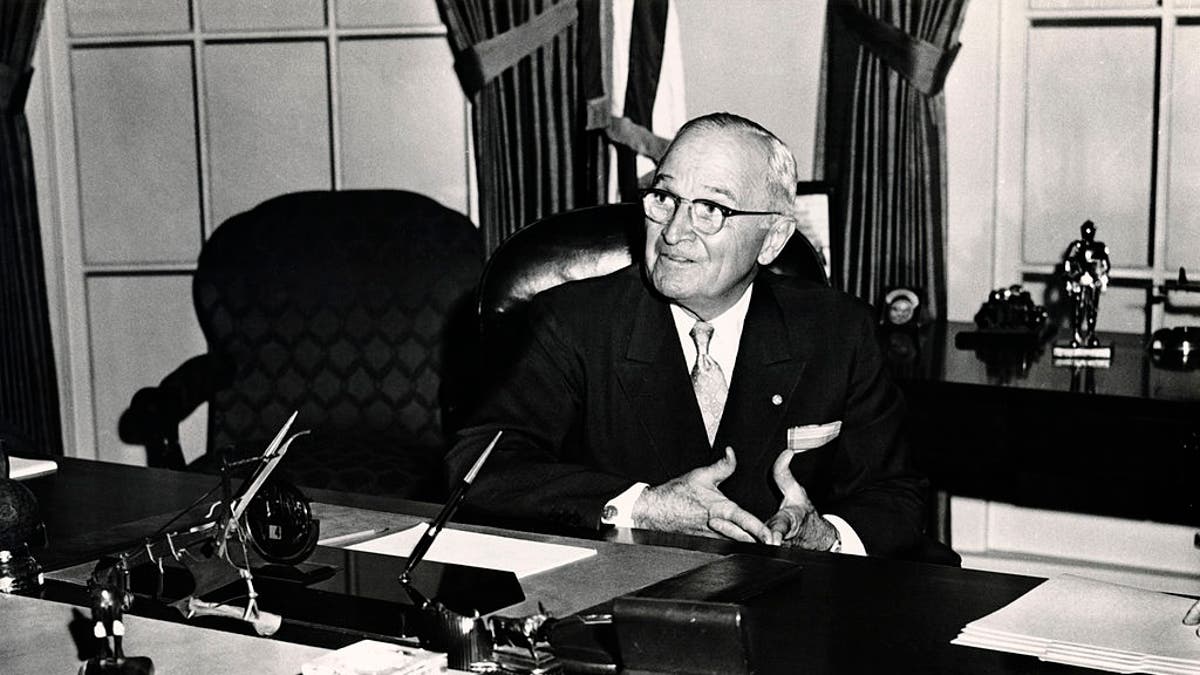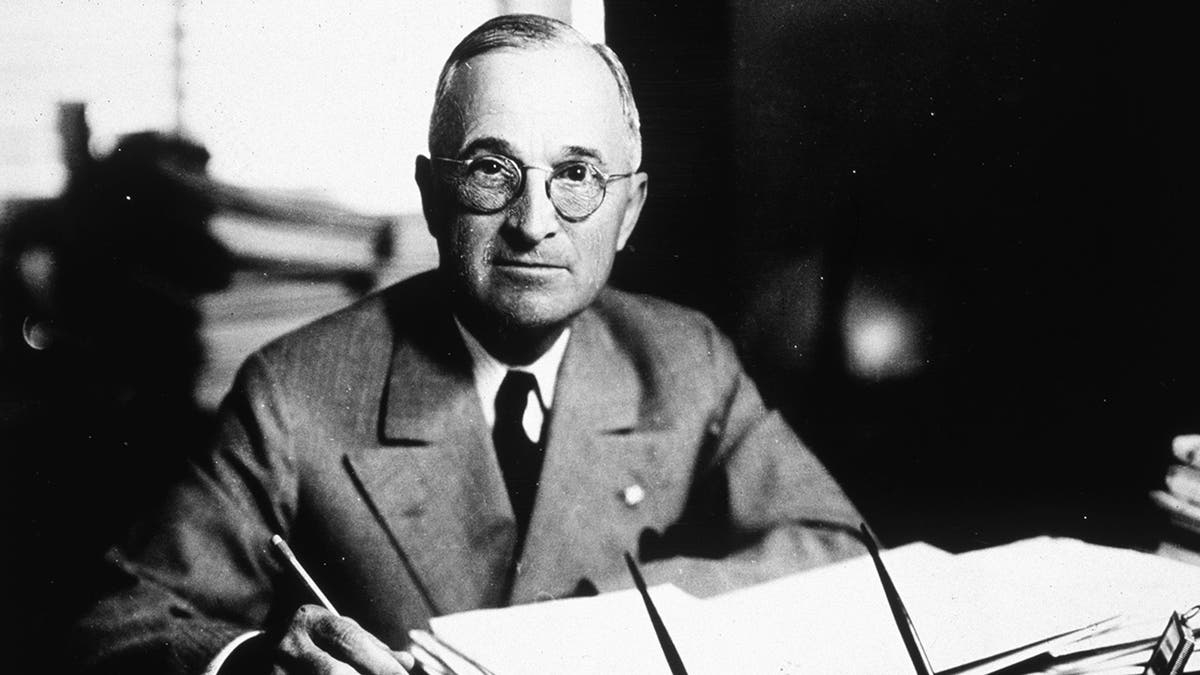WWII veterans tell their heroic stories in new Fox Nation special
Fox News' Martha MacCallum previews her new Fox Nation documentary, 'The Final Journey of the Greatest Generation,' on 'The Story.'
The Potsdam Conference shaped the diplomacy of the end of World War II.
And on this day in history, July 17, 1945, following Nazi Germany's surrender in the war, President Harry S. Truman, British Prime Minister Winston S. Churchill and Soviet leader Josef Stalin began meeting at Potsdam, a suburb of Berlin, Germany, in the final Allied summit of World War II, according to Britannica.com.
The purpose of the conference was to negotiate the terms for the end of World War II.
ON THIS DAY IN HISTORY, JULY 16, 1911, AMERICAN ACTRESS AND DANCER GINGER ROGERS IS BORN
The three most pressing issues discussed at Potsdam concerned how to handle a defeated Germany; the fate of Poland; and the final destruction of Japanese military power, according to The National WWII Museum in New Orleans.
"Questions dealing with German reparations, the economic rehabilitation of Germany, Poland’s postwar borders and the composition of Poland’s government proved to be the most contentious," the same source recounted.

American President Harry S. Truman seated in the White House library, circa 1950. On July 17, 1945, following Nazi Germany's surrender in the war, President Truman, British Prime Minister Winston S. Churchill and Soviet leader Josef Stalin began meeting at Potsdam, a suburb of Berlin, Germany, in the final Allied summit of World War II. (Fotosearch/Getty Images)
These esteemed world leaders worked out many of the details of the postwar order in the Potsdam Agreement, signed on August 1, stated History.com.
They confirmed plans to disarm and demilitarize Germany, which would be divided into four Allied occupation zones controlled by the United States, Great Britain, France and the Soviet Union, the same source chronicled.
The formation of a Council of Foreign Ministers was also approved.
The agreement also outlined plans to drastically remake German society, by repealing laws passed by the Nazi regime and removing Nazis from the German education and court systems — and to arrest and try Germans who had committed war crimes, according to History.com.
ON THIS DAY IN HISTORY, OCT. 25, 1944, FIRST KAMIKAZE SUICIDE PILOTS ATTACK US NAVY IN WORLD WAR II
Additionally, the formation of a Council of Foreign Ministers was approved.
It would act on behalf of the United States, Great Britain, the Soviet Union and China to write peace treaties with former German allies, such as Italy and Bulgaria, said the same source.
A controversial matter addressed at the Potsdam Conference was the revision of the German-Soviet-Polish borders and the expulsion of several million Germans from these disputed territories, according to the Office of the Historian, Foreign Service Institute, United States Department of State.

Winston Churchill (1874-1965) gives his famous v-sign as he opens the new headquarters of 615 (County of Surrey) Squadron of the RAAF (Royal Auxiliary Air Force) at Croydon in 1948. (Central Press/Hulton Archive/Getty Images)
"In exchange for the territory it lost to the Soviet Union following the readjustment of the Soviet-Polish border, Poland received a large swath of German territory and began to deport the German residents of the territories in question, as did other nations that were host to large German minority populations," the same source recounted.
The Potsdam Conference is perhaps best known for President Truman’s July 24, 1945, conversation with Stalin.
ON THIS DAY IN HISTORY, APRIL 1, 1945, US FORCES INVADE OKINAWA, LAST MAJOR BATTLE OF WORLD WAR II
Truman told the Soviet leader that the United States had successfully detonated the first atomic bomb on July 16, 1945, said the United States Department of State.
"Historians have often interpreted Truman’s somewhat firm stance during negotiations to the U.S. negotiating team’s belief that U.S. nuclear capability would enhance its bargaining power," said the same source.

Shown in 1945, Harry S. Truman (1884-1972), the 33rd president of the United States. After succeeding Franklin D. Roosevelt to power during the last months of World War II, Truman was forced to make the decision to end the war with Japan by dropping the atomic bomb. (MPI/Getty Images)
Stalin, however, was already well-informed about the U.S. nuclear program thanks to the Soviet intelligence network; so he also held firm in his positions, and this situation made negotiations challenging, according to the U.S. Department of State.
Another important issue of the Potsdam Conference was to pressure Japan, which was still in the war.
On July 26, the United States and Great Britain, along with China, issued the Potsdam Declaration, which threatened a severe aerial and naval attack and land invasion that would "strike the final blows upon Japan," unless the Japanese agreed to surrender, cited History.com.
"The declaration laid out the Allies’ non-negotiable terms for peace, which included unconditional surrender and disarming of the Japanese military, occupation of Japan ‘until there is convincing proof that Japan’s war-making power is destroyed’ and trials for Japanese war criminals, and creation of a democratic system of government with freedom of speech and other rights for citizens," the same source stated.
"The declaration laid out the Allies’ non-negotiable terms for peace."
The Japanese government initially rejected the declaration outright.
For more Lifestyle articles, visit www.foxnews.com/lifestyle
It later agreed to it, however, after atomic bombs were dropped on Hiroshima and Nagasaki, and the Soviet Union invaded Japanese territory, according to the Atomic Heritage Society.
CLICK HERE TO SIGN UP FOR OUR LIFESTYLE NEWSLETTER
"Some have theorized that the declaration’s final threat referenced the atomic bomb," the same source cited.
CLICK HERE TO GET THE FOX NEWS APP
Potsdam was the final time that leaders of the United States, Great Britain and the Soviet Union, who had maintained a tense alliance despite their differences during the war, would meet to discuss postwar cooperation, according to History.com.


